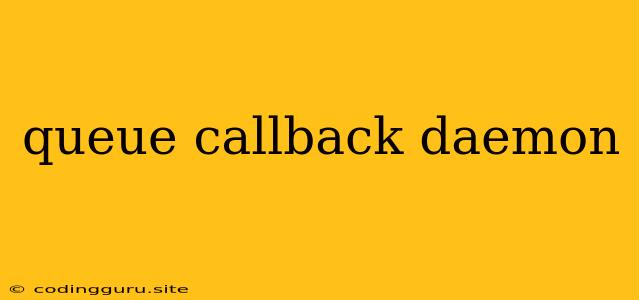Understanding the Power of Queues, Callbacks, and Daemons: A Comprehensive Guide
In the realm of software development, efficiency and responsiveness are paramount. This is especially true when dealing with tasks that may take a significant amount of time to complete, such as processing large amounts of data, handling complex calculations, or interacting with external systems. Enter the concept of queues, callbacks, and daemons, a powerful trio that can revolutionize how your applications handle such demanding workloads.
What is a Queue?
Think of a queue as a virtual waiting room. It's a data structure that follows the First-In, First-Out (FIFO) principle, meaning that the first task added to the queue is the first one to be processed. This structure ensures that tasks are executed in a predictable order, preventing any task from being skipped or prioritized unfairly.
Here's how queues are used in practice:
- Web Server Handling: Queues are widely used by web servers to manage incoming requests. When a server receives a request, it can be placed in a queue until the server is ready to process it. This prevents overload and ensures that each request is handled in a fair and timely manner.
- Background Tasks: Queues are ideal for managing background tasks, such as sending emails, generating reports, or performing data analysis. You can add these tasks to a queue, and a separate process or daemon can handle them asynchronously, freeing up your main application to continue running without delays.
The Role of Callbacks
Callbacks are like messengers. They are functions that are passed as arguments to other functions and are executed at a later time. Callbacks allow you to define how your application should react to a particular event or the completion of a task.
Let's look at some scenarios where callbacks come into play:
- Asynchronous Operations: Callbacks are essential for handling asynchronous operations, which are tasks that may not complete immediately. Instead of waiting for the task to finish, your code can proceed with other tasks while the asynchronous operation runs in the background. When the operation completes, the callback function is invoked, allowing you to handle the result.
- Event Handling: Callbacks are crucial in event-driven programming, where your application reacts to events like user input, network requests, or timer expirations. The callback function is executed when the corresponding event occurs.
What Are Daemons?
Daemons are programs that run in the background, continuously performing tasks without requiring user interaction. They are essential for managing system processes, handling network communication, and orchestrating background tasks.
Here's a glimpse into the world of daemons:
- System Services: Daemons are often used to implement system services, such as managing network connections, handling file systems, or running cron jobs.
- Queue Processing: Daemons are perfect for processing tasks that are queued up, such as jobs in a database queue or requests in a web server queue. They continuously monitor the queue, pick up tasks, and process them according to the defined logic.
Combining Queues, Callbacks, and Daemons: A Powerful Workflow
These three components work together seamlessly to create a robust and efficient system. Here's how:
- Queueing Tasks: Tasks that require processing are added to a queue.
- Daemon Monitoring: A daemon continuously monitors the queue, waiting for new tasks to arrive.
- Task Processing: When a new task is available, the daemon retrieves it from the queue and begins processing.
- Callback Execution: The daemon uses callbacks to handle the result of task processing. The callback function is executed once the task is completed, allowing you to take appropriate actions based on the outcome.
Consider this example:
Imagine an e-commerce website that processes large orders. Instead of handling each order immediately, the website can add the order to a queue. A background daemon can then process the order, including tasks like inventory management, payment processing, and shipping arrangements. When the processing is complete, a callback function can be triggered to send a notification to the customer.
Benefits of Using Queues, Callbacks, and Daemons
- Improved Efficiency: By offloading tasks to a separate queue and daemon, your primary application can continue running without interruption, improving performance and responsiveness.
- Scalability: You can easily scale your system by adding more daemons to handle an increased workload.
- Resilience: If one daemon fails, other daemons can pick up the slack, ensuring that your system remains functional.
- Modularity: You can develop and manage tasks independently, making it easier to maintain and update your application.
Conclusion
Queues, callbacks, and daemons are essential tools for building powerful and scalable applications. By understanding how these concepts work together, you can design systems that handle demanding tasks efficiently and reliably. Whether you're building web applications, backend systems, or data processing pipelines, mastering these concepts will empower you to create robust and scalable software solutions.
